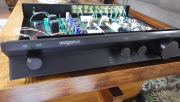Huh???
I have never seen any of that dialog here Al.
Think of it this way, the basic circuit of the preamp, by design has a certain PSRR, Power Supply Rejection Ratio inherent to it. If it is op amp based, the natural PSRR will be something on the order of 80-90dB. This means that any noise coming in from the power supply will be 80-90 dB down on the signal being amplified. This is also frequency dependent, the higher the frequency, the lower the PSRR. So you want to focus more on higher frequency power supply purity where the circuit rejection falls off. Bypassing using capacitors helps this, especially when located right at the load. Putting a small value bypass cap far away from the load is diminished in effect by the wiring/trace to get the power from the source to load due to wire or trace inductance.
A regulated Power Supply also has a specified rejection ratio and that typically is greater than 70dB.
If you put those 2 rejection ratios in series, you gain the benefit of the cascading noise rejection of the basic circuit plus the power supply. Unregulated supplies rely primarily on capacitors to provide rejection ratios and electrolytics are generally not very good at providing as the frequency goes up and where you need it most.
The most prized preamps will use well regulated power supplies. The cascading effect is large. Even if you cannot hear it, it will be measurable. Preamps also do not require much power, even for transients, most not exceeding a watt or two. So the thought that you need massive power supplies for a preamp generally do not exist, unless it is a design like the Accuphase where it is essentially a low power, power amp disguised as a preamp.
The effect of remoting a regulated power supply may or may not improve noise performance, depending on how it gets implemented. Moving to a separate shielded (ferrous) enclosure will help eliminate/reduce any transformer generated stray flux circuit pickup in the preamp circuits. Depending where the stray flux introduces itself into the physical preamp circuit, the preamp may not be able to reject it. The preamp cannot tell a stray flux input signal from the intended signal and will amplify both. The wiring from the remoted PS may be a source of noise pickup and it also introduces a relatively large amount of inductance which is not desirable. Care must be taken at the preamp end of a long wire run to quell the effects of that inductance.






